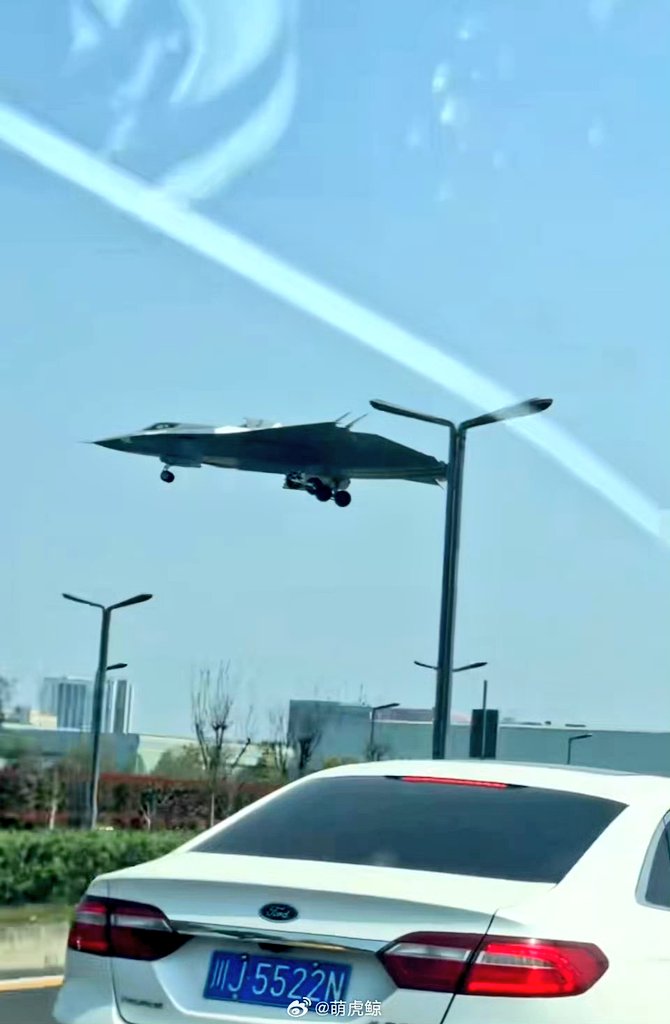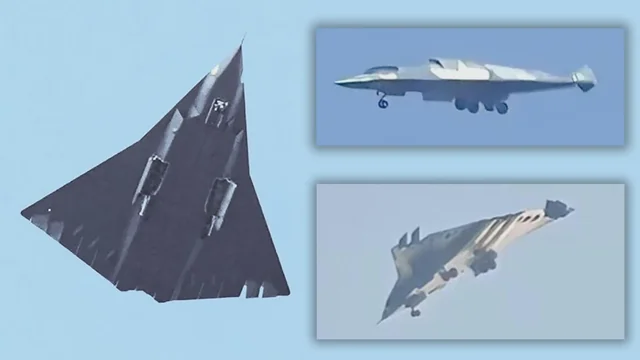(VIDEO) China’s Phantom Unleashed: Rare Video Reveals J-36 Stealth Fighter in Dramatic Low Flyover
(VIDEO) The sudden appearance of the J-36 in such a public setting has prompted speculation about whether the leak was accidental—or a carefully calibrated psychological operation aimed at signalling strategic intent.
(DEFENCE SECURITY ASIA) — On April 7, 2025, a fleeting four-second video quietly uploaded online ignited global defence circles, offering the clearest glimpse yet of China’s elusive sixth-generation stealth fighter, the J-36, in flight.
Captured from a civilian vehicle, the low-resolution but compelling footage shows the stealth aircraft descending over a congested urban highway—an unmistakable silhouette of emerging Chinese airpower, slicing through the smog of Chengdu.
The scene unfolds during the aircraft’s final approach to the Chengdu Airframe Plant, the top-secret aerospace facility in Sichuan province believed to be central to China’s next-generation combat aircraft development.
Located roughly six nautical miles northwest of Chengdu’s city core, this facility has long been cloaked in secrecy, producing some of Beijing’s most advanced aerospace prototypes under the auspices of the Aviation Industry Corporation of China (AVIC).
The sudden appearance of the J-36 in such a public setting has prompted speculation about whether the leak was accidental—or a carefully calibrated psychological operation aimed at signalling strategic intent.
While China typically enforces draconian controls over military media leaks, the precision of the moment and the vantage point from which the video was taken suggest that the footage may have been greenlit at high levels of the Chinese military-industrial hierarchy.
Analysts note that such a rare sighting may serve as strategic messaging amid deepening tensions between Beijing and Washington, particularly in the context of the Pentagon’s F-47 Next Generation Air Dominance (NGAD) initiative.
Video Player
00:00
00:00
With NGAD projected to redefine air combat for the United States and its allies, the J-36’s public appearance could be Beijing’s way of declaring that it, too, is carving a credible path toward sixth-generation air superiority.
The J-36 first took to the skies on December 26, 2024—an inaugural flight that, though unpublicized by state media, marked a milestone in China’s ambition to close the technological gap with Western aerospace powers.
Early visual estimates place the J-36 at approximately 72 feet in length with a wingspan of around 66 feet, placing it in the same weight and performance category as the US NGAD platform and Europe’s Tempest/FCAS designs.
Ongoing flight trials are currently pushing the J-36 across a range of mission profiles, from rapid interception to sustained high-altitude stealth cruising, testing both its aerodynamic limits and avionics integration.
Of particular focus is the aircraft’s Electronic Data Control System (EDCS), a core element that fuses mission data, flight control, and onboard AI-assisted threat management into a single combat brain.
Simultaneously, engineers are validating its advanced Active Electronically Scanned Array (AESA) radar, which features rare side-looking modules—a design intended to enhance 360-degree situational awareness in high-threat, multi-domain environments.

What sets the J-36 apart from its Western competitors is its tailless, blended-body airframe and double-delta wing architecture, which together minimize radar cross-section while maximizing lift and maneuverability at subsonic and supersonic speeds.
More striking still is its propulsion configuration: the J-36 is powered by three turbofan engines, a rare choice in modern fighter design that departs from the twin-engine setups employed by the NGAD, GCAP, and FCAS programs.
According to military analysts, the addition of a third engine could deliver several operational advantages—including increased thrust-to-weight ratio, longer combat radius, and propulsion redundancy in case of engine failure, thus enhancing survivability in contested airspace.
This configuration may also allow the J-36 to conduct long-range strike missions across the Western Pacific, reach into the South China Sea, or loiter near Taiwan’s ADIZ while retaining sufficient power to engage or evade adversaries.
Leaked performance data suggests the J-36 is capable of reaching a top speed of Mach 2.4 (approximately 2,900 km/h) at an altitude of 11,500 meters, placing it among the fastest stealth aircraft in development globally.
Its supercruise capability—sustained supersonic flight without the use of afterburners—is reportedly clocked at Mach 1.8 to 1.9 (2,100 to 2,200 km/h), which, if validated, would place it near the performance threshold of the F-22 Raptor and potentially above the projected specs of NGAD.


With its tri-engine architecture, advanced avionics, and unconventional aerodynamics, the J-36 signals a bold shift in Chinese combat aircraft design—one not content to imitate Western models but to outflank them through asymmetry.
Whether the J-36 is a true sixth-generation platform or an advanced fifth-generation-plus prototype remains a matter of international debate, but its emergence is undoubtedly reshaping the balance of aerospace power in the Indo-Pacific.
As the United States, Japan, the UK, and Europe push forward with their own sixth-generation fighters under NGAD, GCAP, and FCAS, China’s J-36 appears poised to be a serious competitor—if not a disruptor—in the air dominance equation.
The brief, unassuming video that surfaced on April 7 may thus represent more than an accidental glimpse—it could be a glimpse into the next chapter of strategic rivalry unfolding 11,000 meters above the Earth, where stealth, speed, and data supremacy will define the next great contest of airpower.
— DEFENCE SECURITY ASIA


